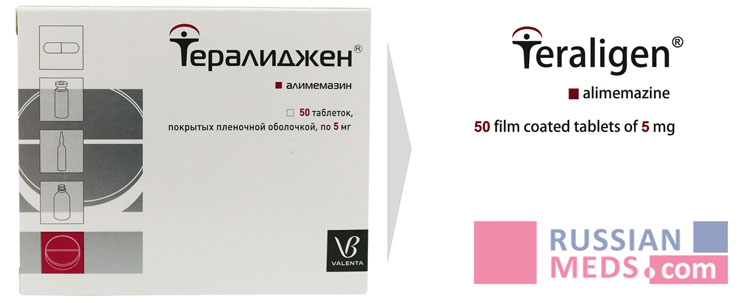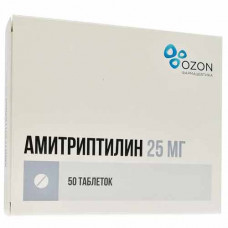
Teraligen®
Active substance - Alimemazine, it acts as a mild sedative and anti-anxiety agent, has a positive effect on senestopathy, obsession and phobia. Teraligen® is used for psychosomatic manifestations that develop as a result of neurovegetative disorders, vascular, traumatic and infectious disorders of the central nervous system. The sedative effect contributes to the normalization of sleep in patients of this category. It has antiemetic and antitussive activity. Sedative and anxiolytic action is due to the blockade of adrenoreceptors of the reticular formation of the brain stem. The antiemetic and vegetostabilizing effect is due to the blockade of dopamine D2 receptors in the trigger zone of the vomiting center. Due to its antihistamine activity, Teraligen® is used for allergic diseases, especially of the respiratory tract, and for pruritus. The antipruritic effect is due to the effect on histamine receptors of the first type.
Pharmachologic effect:
Anxiolytic, neuroleptic (antipsychotic)Pharmacodynamics:
Alimemazine is a phenothiazine derivative. Alimemazine acts as a mild sedative and anti-anxiety agent, has a positive effect on senestopathy, obsession and phobia. It is used for psychosomatic manifestations that develop as a result of neurovegetative disorders, vascular, traumatic and infectious disorders of the central nervous system. The sedative effect of Alimemazine contributes to the normalization of sleep in patients of this category. It has antiemetic and antitussive activity. Sedative and anxiolytic action is due to the blockade of adrenoreceptors of the reticular formation of the brain stem. The antiemetic and vegetostabilizing effect is due to the blockade of dopamine D2 receptors in the trigger zone of the vomiting center. Due to its antihistamine activity, alimemazine is used for allergic diseases, especially of the respiratory tract, and for pruritus. Alimemazine is more active in antihistamine and sedative action than diprazine. The antipruritic effect is due to the effect on histamine receptors of the first type.
Pharmacokinetics:
Alimemazine is rapidly and completely absorbed by any route of administration. The action of alimemazine begins 15-20 minutes after administration and lasts 6-8 hours. Communication with plasma proteins is 20-30%. Metabolized in the liver. Excreted by the kidneys - 70-80% as a metabolite (sulfoxide).
Indications:
In adults and children from 7 years :
As a sedative (calming), anxiolytic (anti-anxiety) and sleep aid:
- dementia (including dementia due to epilepsy) occurring with manifestations of psychomotor agitation, anxiety affect (as part of combination therapy);
- organic anxiety disorder (as monotherapy or as part of combination therapy);
- schizophrenia (with a predominance of neurosis-like disorders, as part of combination therapy);
- mood disorders (affective disorders, as part of combination therapy);
- generalized anxiety disorder (as part of combination therapy);
- obsessive-compulsive disorder (as part of combination therapy);
- reaction to severe stress and adjustment disorders (acute reaction to stress, post-traumatic stress disorder, unspecified reaction to severe stress, other reactions to severe stress, as part of combination therapy);
- dissociative (conversion) disorders (as part of combination therapy);
- somatoform disorders (somatoform disorder, undifferentiated somatoform disorder, hypochondriacal disorder, somatoform dysfunction of the autonomic nervous system, persistent somatoform pain disorder, unspecified somatoform disorder, other somatoform disorders, as part of combination therapy for severe anxiety or ineffective standard therapy);
- unspecified disorder of the autonomic (autonomic) nervous system, other disorders of the autonomic (autonomic) nervous system (as part of combination therapy);
- anorexia nervosa (as part of combination therapy);
- emotionally unstable personality disorder (impulsive and borderline types, as part of combination therapy);
- hysterical personality disorder, anxious (avoidant, avoidant) personality disorder (as part of combination therapy);
- persistent personality change after experiencing a catastrophe (as part of combination therapy);
- hyperkinetic conduct disorder (as part of combination therapy);
- conduct disorder limited to the family (as part of combination therapy with the ineffectiveness of standard therapy);
- unsocialized conduct disorder (in the form of monotherapy or as part of combination therapy);
- anxiety, agitation and other symptoms and signs related to the emotional state (as part of combination therapy);
- other neurotic disorders (neurasthenia, unspecified neurotic disorder, as part of combination therapy);
- insomnia of non-organic etiology (as part of combination therapy with the ineffectiveness of standard therapy);
- emotional disorders with onset specific to childhood (phobic anxiety disorder in childhood, social anxiety disorder in childhood, sibling rivalry disorder, unspecified emotional disorder in childhood, other emotional disorders in childhood, in combination therapy).
As an antiallergic agent:
- itching regardless of location and etiology (itching of the anus, itching of the vulva, unspecified anogenital itching, itching with photocontact dermatitis and solar urticaria, dermatitis, eczema, urticaria, bites or stings by non-venomous insects or other non-venomous arthropods, chickenpox, measles, Hodgkin's disease, diabetes mellitus, herpes zoster) as monotherapy or as part of combination therapy;
- asthma, hay fever, whooping cough (as part of complex therapy as an antiallergic agent for coughing, shortness of breath and asthma attacks);
- unspecified allergy (as monotherapy or as part of combination therapy).
In children from 3 years
As an antiallergic agent:
- itching regardless of location and etiology (itching in photocontact dermatitis and solar urticaria, dermatitis, eczema, urticaria, bites or stings from non-venomous insects or other non-poisonous arthropods, chicken pox, measles, Hodgkin's disease, diabetes mellitus, herpes zoster, anal pruritus, pruritus vulva, unspecified anogenital pruritus, as monotherapy or as part of combination therapy).
As a sedative (calming) agent:
- with medical preparation for surgery (for the purpose of sedation before surgery).
Contraindications:
- hypersensitivity to the components of the drug;
- lactose intolerance, lactase deficiency, glucose-galactose malabsorption;
- angle-closure glaucoma;
- prostatic hyperplasia;
- severe hepatic and / or renal failure;
- parkinsonism;
- myasthenia gravis;
- Reye's syndrome;
- simultaneous use of MAO inhibitors;
- pregnancy;
- lactation period;
- children's age up to 3 years when used as an antiallergic agent and for sedation before surgery, up to 7 years - for other indications.
Use with caution:
alcoholism, if there are indications of complications in the anamnesis when using phenothiazine drugs; bladder neck obstruction; predisposition to urinary retention; epilepsy; open-angle glaucoma; jaundice; oppression of bone marrow function; arterial hypotension.
Pregnancy and breast-feeding:
Teraligen is contraindicated for use during pregnancy and lactation (breastfeeding).
Side effects:
Side effects are extremely rare and mild.Interaction:
Alimemazine enhances the effects of narcotic analgesics, hypnotics, anxiolytic (tranquilizers) and antipsychotic (neuroleptics) drugs, as well as drugs for general anesthesia, m-anticholinergics and antihypertensive drugs (dose adjustment is required).
Tricyclic antidepressants and anticholinergic drugs increase the m-anticholinergic activity of alimemazine.
Simultaneous use of alimemazine with ethanol may cause increased CNS depression.
Alimemazine weakens the action of phenamine derivatives, m-cholinomimetics, ephedrine, guanethidine, levodopa, dopamine.
Combined use of alimemazine with antiepileptic drugs and barbiturates causes decreasion of the threshold for convulsive activity (dose adjustment is required).
Combined use of alimemazine with beta-blockers may cause a pronounced decrease in blood pressure and arrhythmias
Alimemazine weakens the effect of bromocriptine. With simultaneous use in nursing mothers, an increase in the concentration of prolactin in the blood serum is possible.
Simultaneous use of alimemazine and MAO inhibitors (simultaneous use is not recommended) and alimemazine and phenothiazine derivatives, increases the risk of arterial hypotension and extrapyramidal disorders.
Simultaneous use of alimemazine with drugs that inhibit bone marrow hematopoiesis, increases the risk of myelosuppression.
The combined use with hepatotoxic drugs may increase the manifestations of hepatotoxicity of the latter.
Dosing and Administration:
Teraligen is taken orally without chewing. The effect of the drug is dose-dependent, doses are selected depending on the goals of therapy.
Adults :
To achieve a vegetative-stabilizing effect - 15-60 mg / day.
To achieve an anxiolytic effect - 20-80 mg / day.
To achieve a sedative and / or hypnotic effect - 5-10 mg once (20-30 minutes before bedtime).
For symptomatic treatment of allergic reactions - 10-40 mg / day.
Course treatment should begin with taking 2.5-5 mg in the evening with a gradual increase in the daily dose to the desired effect. The daily dose can be divided into 3-4 doses. The duration of the course of treatment can be from 2 to 6 or more months and is determined by the doctor.
The maximum dose for adults is 500 mg / day, for the elderly (over 60 years old) - 200 mg / day.
Children from 7 years of age are prescribed according to the following scheme (depending on age and body weight).
To achieve an anxiolytic effect - 20-40 mg / day. The course of treatment should begin with a dose of 2.5-5 mg with a gradual increase in the daily dose to the desired effect. The daily dose can be divided into 3-4 doses.
To achieve a sedative and / or hypnotic effect - 2.5-5 mg once (20-30 minutes before bedtime).
To achieve a sedative effect in violation of behavior in psychotic conditions, it is possible to increase the daily dose to 60 mg / day.
For symptomatic treatment of allergic reactions - 5-20 mg / day. The duration of the course of treatment can be from 2 to 6 or more months and is determined by the doctor.
Children from 3 years old:
For symptomatic treatment of allergic reactions - 2.5-5 mg 3-4 times a day. The duration of the course of treatment can be from 2 to 6 or more months and is determined by the doctor.
For the purpose of sedation before surgery, children from 3 to 7 years old are prescribed at the rate of 2 mg / kg 1-2 hours before surgery. The maximum daily dose is 2 mg/kg.
Special instructions:
Alimemazine may mask the ototoxic effect (tinnitus, dizziness) of concomitantly used drugs.
Alimemazine increases the body's need for riboflavin.
To prevent distortion of the results of skin prick tests for allergens, the drug should be discontinued 72 hours before allergy testing.
During treatment, false-positive results for pregnancy are possible.
During treatment, you should not drink alcohol.
During the treatment with Teraligen, one should not engage in activities that require an increased concentration of attention and speed of psychomotor reactions (driving a car and other vehicles, working with moving mechanisms, the work of a dispatcher and operator).
Teraligen®
in Cyrillic : Тералиджен
SUBSTANCE
Alimemazine
DOSAGE FORM
tablets
MANUFACTURER
In Stock
available pack options :
| 5mg x 100 tablets | $110.00 |
| 5mg x 50 tablets | $41.90 | |
| 5mg x 25 tablets | $46.00 |


